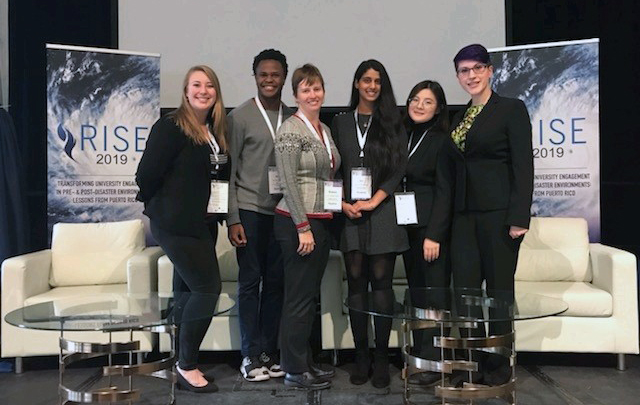
CRC funded five students to attend the 2019 RISE conference at the University of Albany. From left: Emily Gvino, Alex Halloway, UNC faculty member Dr. Shaleen Miller, Siri Nallaparaju, Kejing Zhou and Sarah Lipuma. Photo submitted.
By Emily Gvino, Kejing Zhou, Siri Nallaparaju, Sarah Lipuma and Alex Halloway
On Nov. 17-20, 2019, the Coastal Resilience Center sponsored five students from the University of North Carolina at Chapel Hill and Duke University to travel to New York for the University at Albany’s 2019 RISE conference. The conference’s theme centered on university engagement in pre- and post-disaster environments, specifically in the context of Hurricane María in Puerto Rico. Students attended panels and plenary talks on preparedness, response, and recovery, while networking with practitioners and researchers.
We were inspired by the words of Cecilio Ortiz Garcia, RISE Co-Chair, who said, “You don’t create resilience – resilience is already there in the community.” We have written our collective insights from this experience below.
Public health preparedness and recovery from natural disasters: Public health’s impact after hurricanes and natural disasters
By Emily Gvino (UNC-CH Master of Public Health and Master of City and Regional Planning Candidate, 2021)
The RISE Conference allowed opportunities to explore the research of various aspects of natural disasters, including public health perspectives. Miguel Cruz, the Senior Emergency Operations Officer (CDC/NCEH/EM), led the incident response team coordination through the U.S. Department of Health and Human Services and the Puerto Rico Department of Health. This team was deployed for hurricanes Irma and María, and was responsible for general public health, health communications, epidemiological assessments and restoration of services, including healthcare facility assessment following the CASPER model for immediate health concerns. One of the most stirring moments was when Cruz described the deficiencies in the response efforts from other locations and organizations seeking to help the island. This was one of many ways in which the panel identified improvements that need to be made to university-led response efforts.
“We asked for assets and resources,” Cruz said. “They sent us people who don’t speak Spanish.”
Dr. Amy Nitza presented on research regarding mental health post-disasters. Their sample included 24% of the population of teachers, equally distributed throughout the educational regions, to seek understanding of their perceptions of their students’ mental health. One year after Hurricane María, the majority of students were experiencing decreased academic, cognitive and emotional functioning; 75% of children had experienced family separation and 44% had experienced a death in the family. While there weren’t significant differences by region, the length of time that schools were closed (especially for schools closed for over one month) drastically impacted mental health.
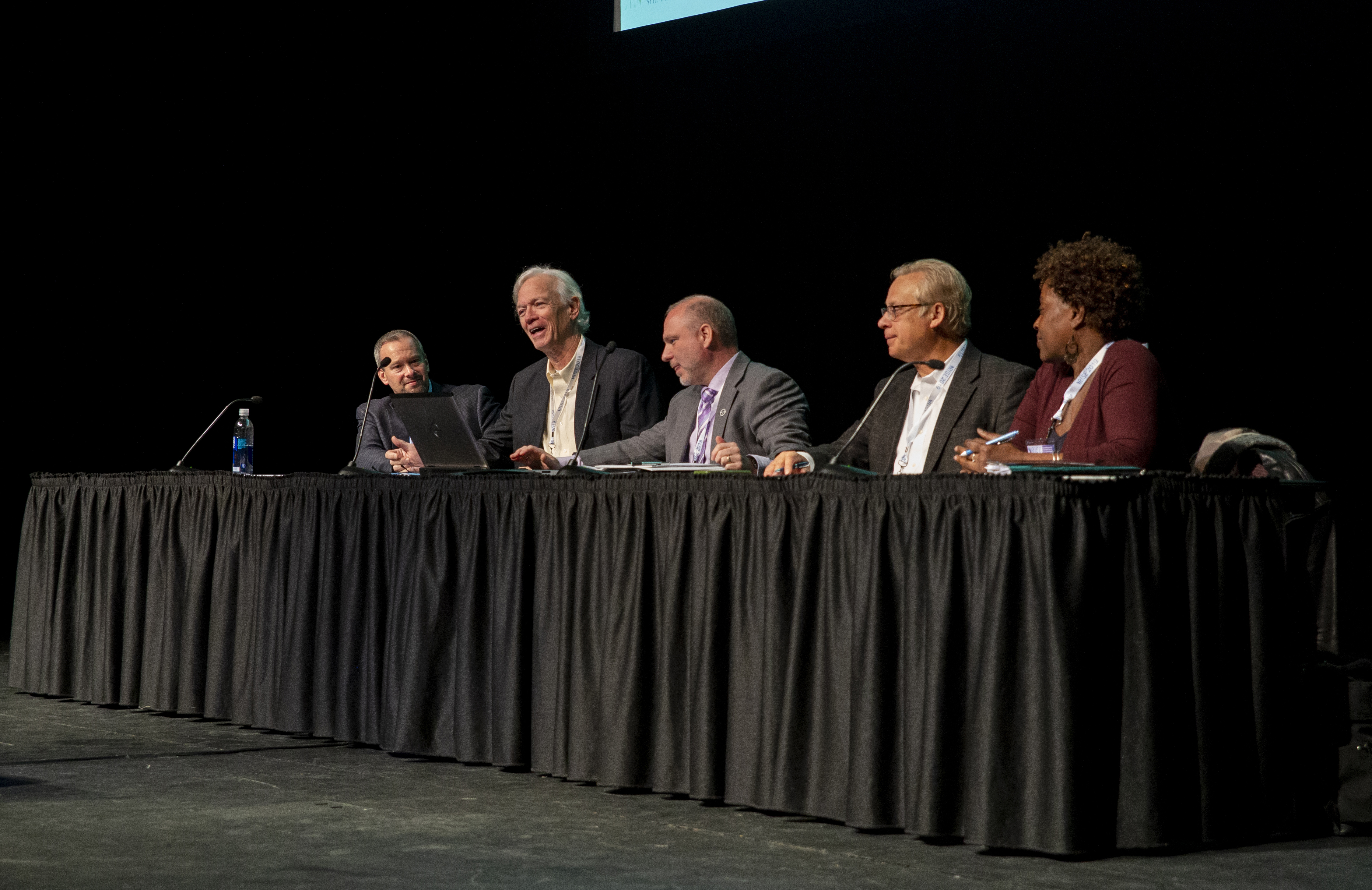
CRC researcher Dr. Phil Berke of UNC-Chapel Hill, second from left, served on a panel called “Integrating Universities with Existing Disaster Planning and Response Frameworks and Doctrines.” Photo By Brian Busher, University of Albany
Beyond tools: Strategies for aiding in adaptation and mitigation
By Kejing Zhou (UNC-CH Visiting Student of City and Regional Planning, Hunan University Master of Urban Planning Candidate, 2021)
Advanced tools for climate adaptation and mitigation can strengthen community resilience considerably. Local government officials and other public and private sector leaders face challenges in selecting the most effective resources from the many available and employing the right practices to benefit their communities and regions. At RISE, panelists from the Environmental Protection Agency (EPA), Environmental Resilience Institute (ERI), Albany Visualization and Informatics Labs (AVAIL) and Federal Emergency Management Agency (FEMA) examined how decision support platforms can be designed to improve the distribution of meaningful information and insights.
The presentation by Dr. Joel Scheraga of EPA gave a practical overview of the Climate Change Adaptation Resource Center (ARC-X). Focused on the community level, the ARC-X supports local government officials to deal with climate impacts, no matter their level of expertise or experience. Dr. Scheraga said the goals of the ARC-X should be “helping communities to choose what they are suitable for.” This web-based system is designed for targeted communities to obtain comprehensive information tailored to their issues of concern, such as air quality control, water quality, flood protection, disaster emergency response and adaptation planning. Dr. Scheraga also identified the importance of “collaboration across boundaries,” as the best scales for mitigating climate changes can often be within geographic regions rather than within administrative boundaries.
“The outcome of model or tool should answer the question of how effective it will be on the ground,” he said.
Dr. Andrea Webster, the implementation manager of ERI, introduced the Hoosier Resilience Index, and discussed how to promote understanding of the resilience models for decision-makers and non-technical laypeople. The Hoosier Resilience Index is an online platform designed to help Midwestern local governments prepare for climate change. Creating multiple layers for three indexes – Extreme heat, Extreme precipitation and Floodplain Land Use – the Hoosier Resilience Index firstly describes current and projected climate change impacts statewide and countywide. Using readiness scores from 1 to 5 provided by the index system, communities can evaluate their sensitivity in different climate scenarios. Thus, the visualized maps and readable reports help local governments to prioritize next step actions to increase readiness. Dr. Webster said that for those cities and towns unable to adapt their own models, the state-level tool can facilitate decision-making processes significantly.
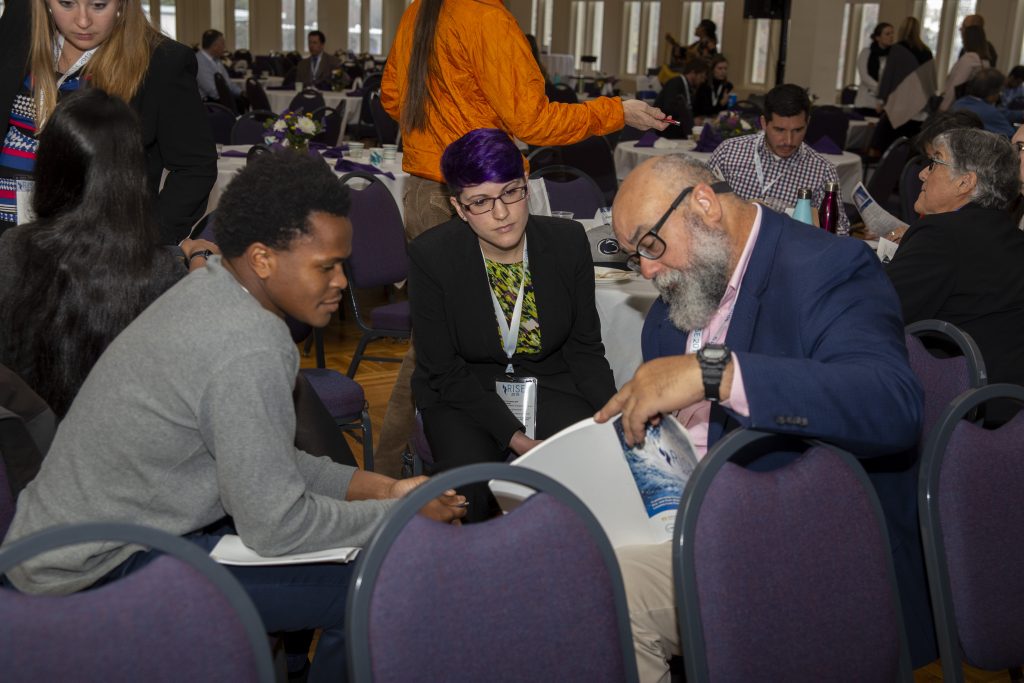
From left: CRC students Alex Halloway of UNC-Chapel Hill and Sarah Lipuma of Duke University discuss presentations with Cecilio Ortiz García, Senior RISE Fellow with the National Council for Science and the Environment. Photo By Brian Busher, University of Albany.
University role in relief: Reflections on new roles in disaster response
By Alex Halloway (UNC-CH Master of City and Regional Planning Candidate, 2020)
Over the course of the conference I found myself gravitating towards the panels that focus on the role that universities can play in disaster planning and recovery. One of these panels was called “University Role in Relief: Reflections on the Universities New Roles in Disaster Response.” This panel had representatives from Texas A&M University, Arizona State University, University of Puerto Rico at Mayagüez, Tufts University and the University at Albany. The panel was moderated by Ethel Marie Ríos Orlandi from the University of Puerto Rico, Rio Piedras campus.
There were two speakers in particular that stuck out to me during this panel. The first was Cory Arcak from the Jordan Institute for International Awareness at Texas A&M. She spoke to the audience about her experience setting up a student service-learning project that assisted with the post- María efforts in the summer of 2018. Arcak began by sharing a video that featured student testimonials about the project, in which many spoke about how being a part of the project better taught them how to assist affected communities while recognizing that the community members themselves are the ones that should “be in the driver’s seat.” As one student said, being a part of the project meant learning to “to be a servant and not just a helper.” Not only this, but many of the students recognized that the community members were not just looking for service but for a chance to tell their stories so that their situations and lives could better be known. Arcak also spoke about some of the practical steps she had to use to leverage support from her university for the project. This later led to a discussion during the Q&A session about how post-disaster planning should not just be focused solely on the built environment, but also on economic development in order to empower the effected members of the community.
The second speaker that stuck out to me was Angélica Valdés Valderrama, a doctoral student in Food Nutrition and Policy at Tufts University (one of two doctoral students on the panel). She spoke on her community activism experience after María with the organization Brigada Solidaria del Oeste. For her, the experience of returning to her homeland to assist with recovery efforts helped her to recognize the privileges she had during that process. It also helped her recognize five areas of post-disaster planning that should be prioritized: Infrastructure, vulnerable groups, mental health, equality and responsible research.
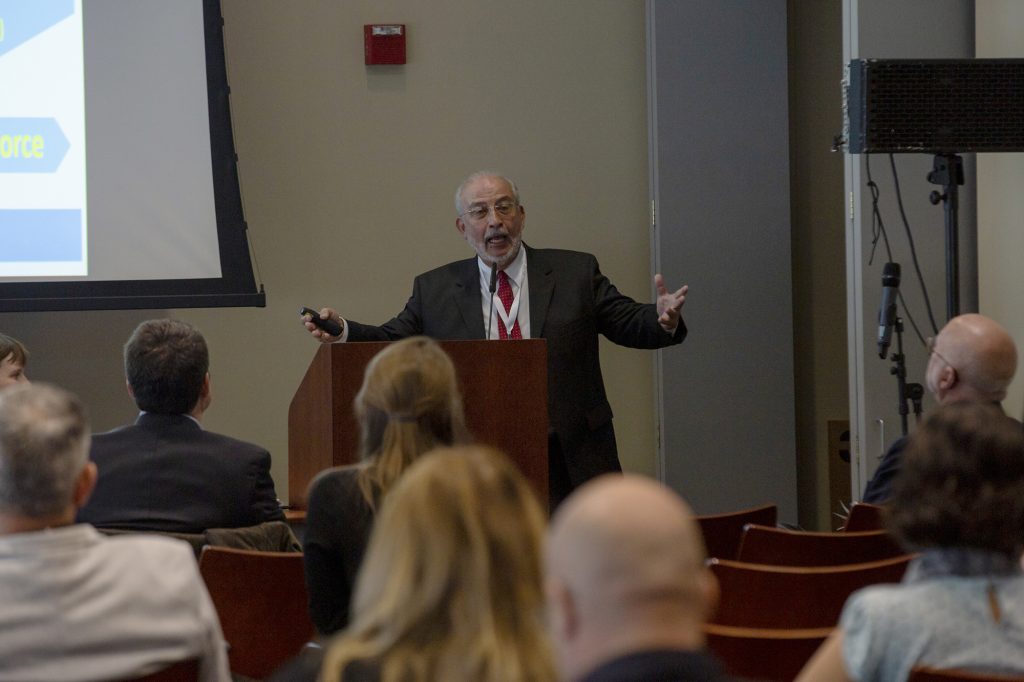
Prof. Ismael Pagan-Trinidad, who leads a CRC education project, spoke on a panel called “Tapping the Potential of Universities to Develop the Next Generation of Disaster Professionals, Knowledge Creation, Campus Resilience Building and Community Service,” at the RISE conference. The panel was moderated by CRC Executive Director Tom Richardson and also included Dr. Shaleen Miller, who leads a CRC-supported speakers series at UNC-Chapel Hill. Photo by Brian Busher, University of Albany.
Engineering and coastal resiliency: A national and international imperative/Infrastructure challenges facing our island communities
By Siri Nallaparaju (UNC-CH Master of City and Regional Planning Candidate, 2020)
While most of the panels were on university’s role and relationship with other disaster practitioners, this talk was about infrastructure challenges that were only realized when the hurricanes struck Puerto Rico in 2017. Ricardo López, Professor of Civil Engineering at the University of Puerto Rico-Mayagüez and CRC researcher, presented some of the main infrastructure challenges that Puerto Ricans faced during and after María. The panel also included Yanna Liang, Professor and Chair, University at Albany, State University of New York; Jorge González-Cruz, NOAA-CESSRST Professor, City University of New York; Joel Lugo, Executive Director for Operations – West Region, Puerto Rico Aqueduct & Sewer Authority and Rafael Rodríguez-Solis, Professor of Electrical Engineering, University of Puerto Rico at Mayaguez. The panelists discussed the challenges from different perspectives such as water, wastewater, power and communication within the island.
They mentioned there was no power for almost two days and there was a lack of communication from one part of the island to another. They also spoke of the advantages of having better communication systems, in whatever way possible, in other catastrophic events such as Hurricane Sandy in New York City, allowing more people to be helped in a shorter amount of time than in Puerto Rico during María. I learned that there are still a lot of gaps to bridge in terms of infrastructure challenges, and drew a parallel between Puerto Rico and a different island case study that I have been studying for the past two years, in Majuli. Majuli is a small riverine island in the Ganga-Brahmaputra region of India. This small island now gets flooded every four months due to the increase in heat and the rapid melting of Himalayan glaciers. Due to the lack of new technology or even the proper condition of old communication systems, the people cannot reach the mainland in any way for at least 24 hours, during which anything may happen.
Professor Rodríguez-Solis mentioned that Puerto Rico did not have a written, updated agency crisis and emergency risk communication plans in place prior to María. Due to the lack of power, this contributed to a slower, more effective response, since it was hard to know what the real needs were in towns and cities around the island. Satellite phones, radio operators and VHF handheld units were used at that time. Better access to telecommunications should be a part of the reconstruction efforts, he said, as this will help emergency response be more productive and increase resiliency in terms of immediate response. However, it has not been considered a high priority for federal funding. The professors mentioned that federal assistance is never enough just in terms of basic food stamps and said that if that is the case with basic response, they might never get enough funding for better telecommunication projects. The role of academic research and services to mitigate failures and also policy efforts to get funds should be incorporated in future discussions.
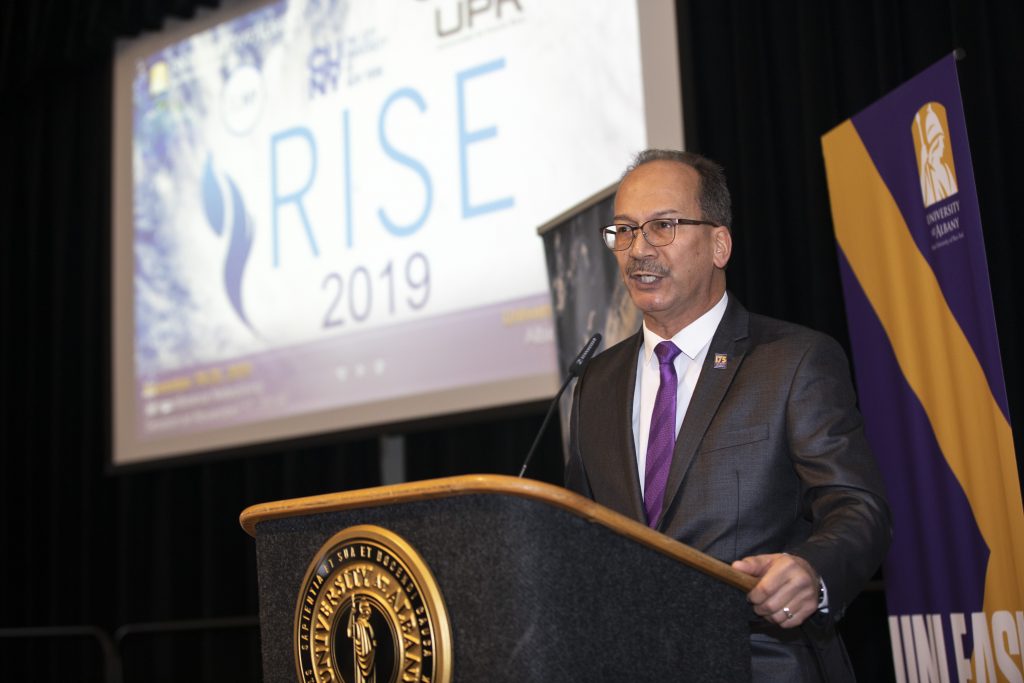
Havidán Rodríguez, President, University at Albany, State University of New York, speaks during the RISE Conference. Photo by University of Albany.
Collaborating with colleagues in extreme operating environments
By Sarah Lipuma (Duke Nicholas School Master of Environmental Management, 2021)
The breakout session on collaborating with peers in extreme environments delved into difficult situations, unique solutions and lessons learned. This session was moderated by Leonardo Flores of Appalachian State University, with panelists Catalina de Onís of Willamette University, Elvia Melendez-Ackerman of the University of Puerto Rico, Aleyda Villavicencio of the Harvard T.H. Chan School of Public Health, Megan Voorhees of the University of Minnesota, and our own Dr. Shaleen Miller of the University of North Carolina. All of the professionals had experience assisting areas affected by extreme events, and were able to give advice on cooperating and creating partnerships with local people, organizations and colleagues.
Some important takeaways were that if you, as a person hoping to help out in a crisis, do not have skills and experience in emergency response, it may be best to help from afar. Examples of ways to help from afar include:
- Helping people file their paperwork that needs to be uploaded online when they do not have internet access
- Providing translation services over the phone
- Organizing fundraising and awareness building events
- Counseling distraught people over the phone
- Donating money and supplies to local charities, especially in the rural areas, and not just cities.
Volunteers may feel compelled to help out because of a strong sense of empathy, but it is important not to self-deploy to an area that has experienced a major disaster without having supplies, skills and other necessities so as not to be a burden on the already fragmented infrastructure.
Havidán Rodríguez, President of the University at Albany, pointed out this need to train volunteers when he said, “We must create a coalition of the willing, a service corps to train and mobilize students to deploy to disasters.”
The other important points made during this session were to be prepared to maintain partnerships and connections over time, even a decade or more; to center the needs and realities of the community first; and to treat survivors with dignity and respect, not as helpless victims.
The ongoing earthquakes that have been trembling the island since early January moved Dr. Marla Perez Lugo, Senior RISE Fellow at the National Council for Science and the Environment, to reaffirm several points that RISE conference attendees agreed upon for approaching disaster response in Puerto Rico in a LinkedIn post on ethical disaster relief.